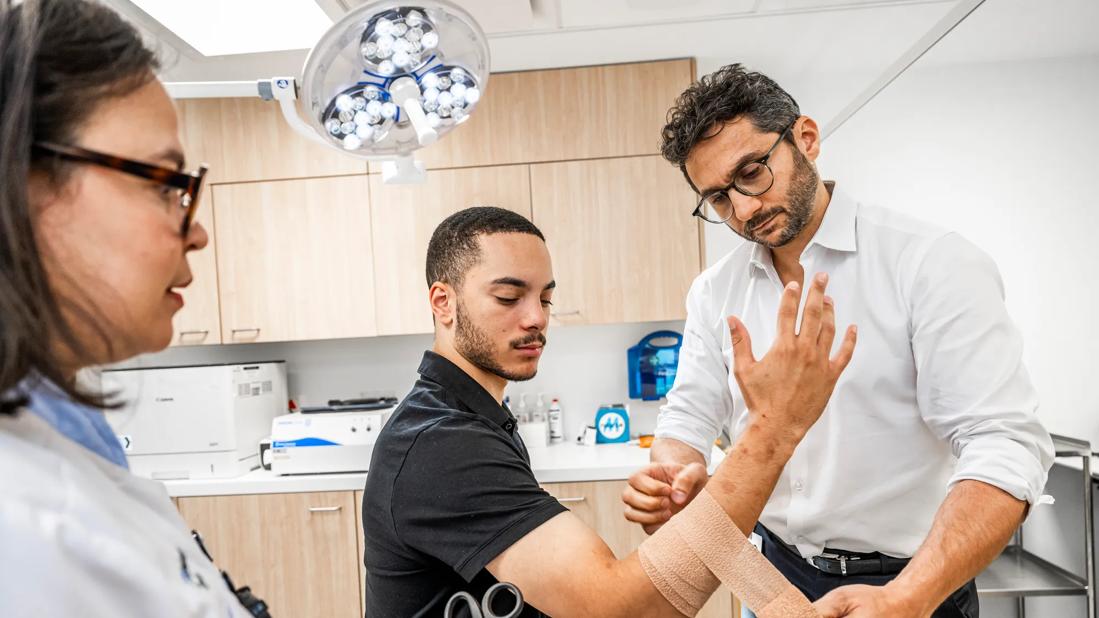Minimal risk procedures have excellent efficacy and safety profiles

The practice of performing wide-awake local anesthesia no tourniquet (WALANT) procedures in an office setting has become a popular alternative for hand surgeries over the past five years, reports Kavita Vakharia, MD, Staff Surgeon in the Department of Plastic Surgery at Cleveland Clinic. “I do 80% of my hand surgeries using a wide-awake approach because there is less risk and more convenience for patients, who don’t need to undergo preoperative testing or fast prior to a procedure, or schedule multiple medical visits. There is also less need for medications, and WALANT can be performed in most office settings.”
Advertisement
Cleveland Clinic is a non-profit academic medical center. Advertising on our site helps support our mission. We do not endorse non-Cleveland Clinic products or services. Policy
WALANT, she says, is an excellent alternative for patients at high risk for deleterious reactions to general anesthetics, including people with obstructive sleep apnea, morbid obesity, cardiovascular disease, renal failure and pulmonary disease. Patients who are taking multiple medications for comorbid conditions also don’t need to disrupt their medication schedules before undergoing WALANT. Contraindications to WALANT include intense patient anxiety, highly complex cases and patient preference for a more traditional setting.
Dr. Vakharia notes that WALANT can be utilized for cases involving carpal tunnel syndrome repair, trigger finger release, Dupuytren’s contracture fasciectomy, extensor and flexor tendon repairs, digital nerve repairs, finger amputations and finger fracture repairs. “By performing the procedure without a tourniquet there is more blood in the surgical field, but patients do not feel pain during the procedure, and there is no need for sedation,” she explains. “Typically, we administer a combination of lidocaine for fast-acting anesthesia and pain relief, bupivacaine for longer-acting anesthesia and pain relief and epinephrine to decrease bleeding.”
Patients undergoing WALANT hand surgeries are not as extensively draped as they are in the main operating room and are allowed to watch the surgery or turn the other way. “They can listen to music or watch a show on a hand-held device or smartphone, and even bring headphones with them to completely drown out the experience. We also play music in the room if they prefer to listen to that, and we can talk to them to tell them about what we’re doing or distract them by talking about something else,” she says. Some patients are so relaxed that they fall asleep; anxious patients may occasionally receive oral benzodiazepines prior to the surgery.
Advertisement
Side effects of the local anesthetic/epinephrine cocktail include jittery or shaky feelings, which subside within 15 minutes or so. Some patients may have a vasovagal reaction to the injection, but there are no nausea, vomiting or sedation effects as may occur after patients receive conscious sedation or general anesthesia. A crash cart must be readily accessible should CPR be necessary, and phentolamine should be available to reverse reactions to the local anesthetics and epinephrine. “Adverse reactions are very rare, however,” she says, “and the risk of infection is low.
“Patients really like the option of WALANT, partially because it is so convenient. They don’t have to take as much time off from work or go through check-in at an ambulatory surgical center or hospital,” she adds, “and patients can often drive themselves home after surgery.” Typically, too, it is easier and faster to get on a surgeon’s schedule than it is for non-office-based surgeries. Wound healing and functional recovery time are the same as they would be if the procedure were performed in an ambulatory surgical center or hospital surgical suite.
“COVID-19 restrictions have made office-based procedures like WALANT hand surgeries even more appealing to patients since they involve fewer medical visits and less exposure of the airway.” Patients are required to have preoperative COVID-19 testing, of course, and to wear a mask during the procedure.
WALANT is cost effective, saving anywhere from 80% to 85%, for instance, over operating room procedures to correct carpal tunnel syndrome.
Advertisement
Doing WALANT procedures also has benefits for surgeons. “There is decreased cost to the health care system, better workflow, increased efficiency and time management, and the ability to do more cases in a single day,” Dr. Vakharia reports.
Advertisement
Advertisement

Family history may eclipse sun exposure in some cases

Consider secondary syphilis in the differential of annular lesions

Persistent rectal pain leads to diffuse pustules

Two cases — both tremendously different in their level of complexity — illustrate the core principles of nasal reconstruction

Stress and immunosuppression can trigger reactivation of latent virus

Low-dose, monitored prescription therapy demonstrates success

Antioxidants, barrier-enhancing agents can improve thinning hair